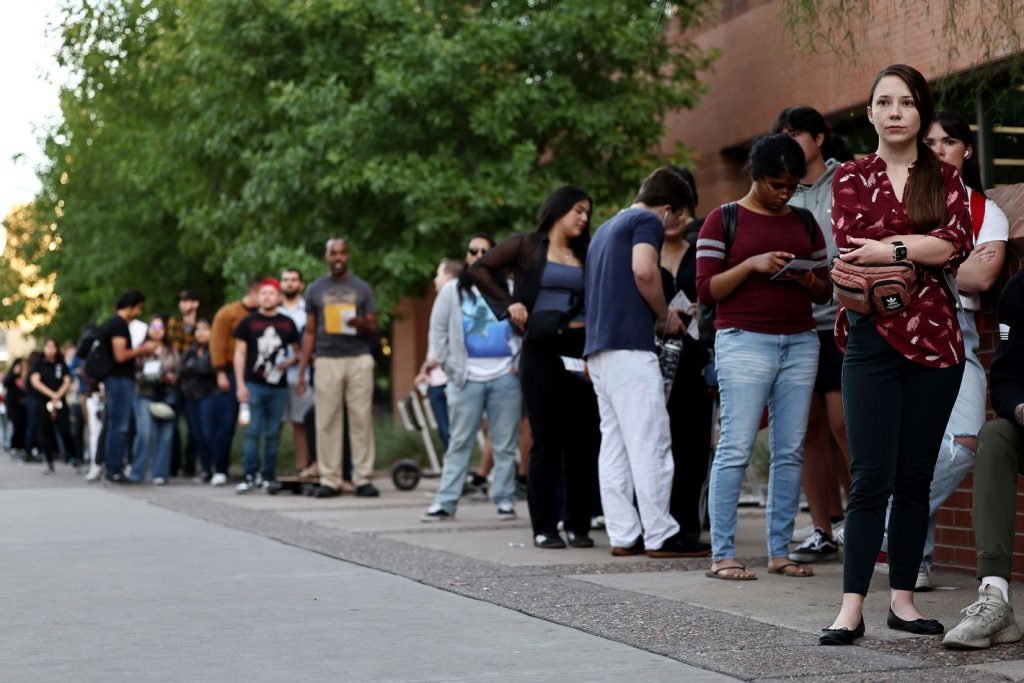Photo: Mario Tama/Getty Images
The 2024 election has been back in the news this week owing to Joe Biden’s cancer diagnosis and the publication of the book Original Sin: President Biden’s Decline, Its Cover-Up, and His Disastrous Choice to Run Again, by Jake Tapper and Alex Thompson. But another reason for a reassessment of last November’s election is that researchers are just now gaining access to complete data on what actually happened via voter files and Census materials.
The progressive data firm Catalist just issued its report on 2024, and much of what it tells us is a familiar story by now:
Overall, we find that the Democratic Kamala Harris / Tim Walz ticket retained key parts of the Biden 2020 coalition, but at lower levels among a specific, interconnected set of subgroups, including young voters, men, voters of color, less frequent voters, urban voters, and voters living outside the major battleground states. No single demographic characteristic explains all the dynamics of the election; rather we find that the election is best explained as a combination of related factors. Importantly, an overarching connection among these groups is that they are less likely to have cast ballots in previous elections and are generally less engaged in the political process.
While these groups tilted toward Donald Trump and JD Vance, Harris retained support among more consistent voters, particularly in battleground states. Together, these dynamics allowed the Trump / Vance ticket to secure a narrow popular vote plurality and a sweep of the major swing states.
The details, of course, are still interesting, particularly when Catalist gets down into the demographic weeds:
Over the past several general elections, Democratic support has continued to erode among voters of color. Drops from 2020 to 2024 were highest among Latino voters (9 points in support), lowest among Black voters (3 points), and 4 points for Asian and Pacific Islander groups (AAPI) … As with other demographic groups, support drops were concentrated among the younger cohorts of voters, particularly young men. For instance, support among young Black men dropped from 85% to 75% and support among young Latino men dropped from 63% to 47%.
But sometimes important data points emerge only when you look at them from 30,000 feet. Given all that we know about the erosion of public trust in institutions, steadily negative perceptions of the direction of the country, a long-term trend away from partisan self-identification, and the savage and alienating tone of contemporary political discourse, you’d guess that voter participation would be sliding into a deep ditch. But it isn’t:
The 2024 election was a continuation of incredibly high turnout following Trump’s surprising victory in 2016, particularly in the battleground states. Since the start of Trump’s first term, voters have remained highly engaged in the political process.
According to data from the United States Election Lab compiled by University of Florida political scientist Michael McDonald … voter turnout spiked from 60% in 2016 to 66% in 2020 — the highest voter turnout in over a century, higher than any election since women’s suffrage and the Civil Rights era. Turnout dropped to 64% in 2024, but this drop was concentrated in non-competitive states, with some battleground states exceeding their 2020 turnout.
So in a country where so many citizens seem to hate politics, voting is occurring (in relative terms) at historically high levels. Catalist doesn’t go into the possible explanations, but three come to mind right away.
First, despite recent Republican efforts to go back to a system dominated by in-person voting on Election Day, convenience-voting opportunities have steadily spread with voting by mail and/or in-person early voting available nearly everywhere, increasingly without conditions. In most jurisdictions, registering to vote has gotten easier in the 21st century, though, again, recent Republican initiatives to require documentary proof of citizenship and promote frequent “purges” of voter rolls definitely threaten to reverse that trend.
Second, competitive elections tend to produce higher voter turnout, particularly at a time of partisan and ideological polarization, when the stakes associated with winning or losing are heightened. Six of the seven most recent presidential elections have been very close either in the popular vote or the Electoral College or both. Control of either the House (2006, 2010, 2018, and 2022) or Senate (2002, 2006, 2014, and 2020) has changed in every midterm election of the 21st century. This level of instability over such an extended period of time is unusual and arguably galvanizing.
Third, the amount of money going into voter mobilization and persuasion in national election cycles has been steadily rising. The campaign-finance tracking site OpenSecrets has shown that in inflation-adjusted dollars, total spending has nearly tripled between 2000 and 2024 in both presidential and midterm elections. 2020 was actually the most expensive election ever with $7.7 billion (again, in inflation-adjusted dollars) going into the Trump-Biden race and $10.6 billion devoted to congressional campaigns. The slightly lower number for 2024 may have been attributable to the incredibly intensive targeting of resources on the seven battleground states, where, overall, as Catalist showed, turnout actually went up a bit from 2020.
These three factors do not, of course, take into account the much-discussed possibility that Donald Trump and his radicalized party are responsible for excited or fearful hordes of Americans going to the polls. But while voting patterns in Trump-era midterms are a bit different from those in the presidential elections when his name has been on the ballot, turnout has been elevated in the midterms, too. Indeed, the leap from a national turnout rate of 37 percent in 2014 to 50 percent in 2018 (dropping only a bit to 46 percent in 2022) remains one of the largest and most astonishing jumps in voter engagement in living memory.
Will these patterns change when (presumably) Trump leaves the scene in 2028? Nobody knows. But the anecdotal impression that Americans have grown tired of politics, and even government, during the Trump years hasn’t translated into unwillingness to vote.

